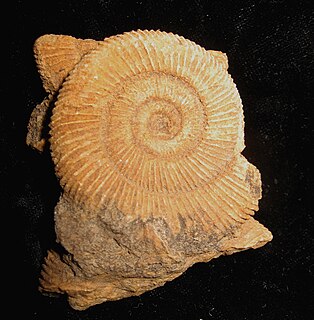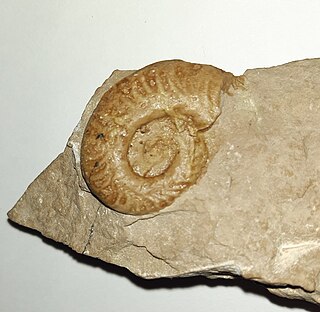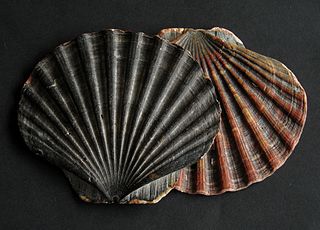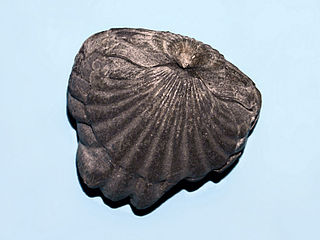
Ammonoids are a group of extinct marine mollusc animals in the subclass Ammonoidea of the class Cephalopoda. These molluscs, commonly referred to as ammonites, are more closely related to living coleoids than they are to shelled nautiloids such as the living Nautilus species. The earliest ammonites appeared during the Devonian, and the last species either vanished in the Cretaceous–Paleogene extinction event, or shortly after during the Danian epoch of the Paleocene.

The Hexanchiformes are the order consisting of the most primitive types of sharks, and numbering just seven extant species. Fossil sharks that were apparently very similar to modern sevengill species are known from Jurassic specimens.

Dactylioceras was a widespread genus of ammonites from the Lower Jurassic period, approximately 180 million years ago (mya).

Asteroceras is an extinct genus of cephalopod belonging to the Ammonite subclass. These fast-moving nektonic carnivores lived during the Triassic and Jurassic periods.

Audaxlytoceras is an extinct genus of lytoceratid ammonites.
Hoffmanniinae is an adrianitid ammonoid cephalopod subfamily established for the Middle Permian genus Hoffmannia.

Hildoceras is a genus of ammonite from the Jurassic period in the family Hildoceratidae. The shells are characterized by a narrow discoidal evolute shape, keeled venter, concave ribs along the outer flanks, and a shallow spiral groove running along smooth inner flanks. Whorls slightly overlap, cross sections are compressed. The ventral keel is bordered on either side by a shallow groove. The genus was named by Alpheus Hyatt after Saint Hilda in 1876.

Pecten is a genus of large scallops or saltwater clams, marine bivalve molluscs in the family Pectinidae, the scallops. This is the type genus of the family.

Chitonida is an order of chitons.

Pleurotomaria is an extinct genus of sea snails, marine gastropod molluscs in the family Pleurotomariidae.

Rhynchonella is an extinct genus of brachiopod found in Ordovician to Eocene strata worldwide. It was a stationary epifaunal suspension feeder.
Giuseppe Giovanni Antonio Meneghini was an Italian botanist, geologist and paleontologist.

Calliphylloceras is an ammonite belonging to the Phylloceratidae.

Spirifer is a genus of marine brachiopods belonging to the order Spiriferida and family Spiriferidae. Species belonging to the genus lived from the Middle Ordovician (Sandbian) through to the Middle Triassic (Carnian) with a global distribution. They were stationary epifaunal suspension feeders.
Ovaticeras is an extinct genus of cephalopod belonging to the family Hildoceratidae. These cephalopods existed in the Jurassic period, during upper Pliensbachian and lower Toarcian. Its fossils were found in Europe, North Africa and possibly also in Canada and Vietnam. It might have evolved from Harpoceras falciferum and died out without leaving any descendants.
Cymbitidae is family of ammonite that lived during Sinemurian and Pliensbachian stages of Lower Jurassic. They have probably evolved from Arietitidae.
Leptopsilopa is a genus of shore flies in the family Ephydridae. There are at least 20 described species in Leptopsilopa.

Gaetano Giorgio Gemmellaro was an Italian geologist, paleontologist and politician.

Mercaticeras is an extinct genus of ammonites belonging to the family Hildoceratidae.
Idmonea is a genus of bryozoans belonging to the family Idmoneidae.














